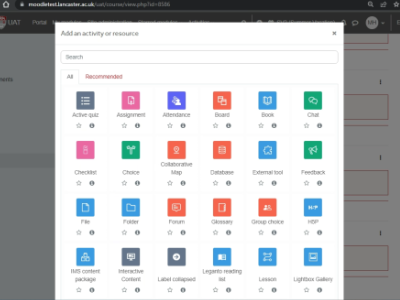
Using Moodle for course delivery
Moodle is Lancaster’s virtual learning environment (VLE), all modules have an associated Moodle course and students will have access to these when studying their course. If you’re unfamiliar with using Moodle, please complete our online Moodle course aimed at staff, and then use these top tips to help you develop an effective online course for your students.
Introduction to Moodle (for staff)
1. Organise Your Course
Consider the layout of your Moodle course - learning resources and activities should be sequenced in a logical order from the start to the end of the course. To avoid long Moodle courses, consider using the Collapsed Topics course format and don’t put too much content in the general section as students will have to scroll past this every time they access the course. Make use of the Page and Book activities (in adding individual items section of Introduction to Moodle course) to move static resources away from the course page thus reducing the page length further. If you're rolling over your Moodle module to another year, remember to delete the content you no longer need.
2. Give Instructions and Context
Make your course aims and learning objectives explicit - do this by adding them to your Moodle course using a Page activity, or link directly to the Module and Programme Catalogue. If you require students to complete online activities, provide clear instructions that outline what should be done and by when. Try to avoid long lists of files and activities. You can use Moodle’s engagement monitoring to monitor student engagement with your course and the restrict access feature to control the way they access course materials.


3. Use a Variety of Resources
You can add a wide variety of learning materials to Moodle such lecture slides, eStream, Panopto or YouTube videos and content from external learning platforms. You should add these to your course with descriptive and consistent titles to make their purpose clear to students. Try to use a variety of resource types to increase engagement in your course. Instead of uploading PDF resources, you may want to consider developing some interactive course materials using tools such as H5P. Where possible, try to make resources available to students in advance of lectures so they have time to prepare and adapt materials to suit their needs. When adding content from external places such as YouTube, consider whether the content will be accessible to all your students (YouTube is blocked in China, for example).
tip 3 accordion accordion
Challenges
- Offering student autonomy in the learning process.
- Encouraging students to learn from mistakes and prompt critical reflection.
Solution
Branching scenarios can be set up using H5P in Moodle to challenge a student to make a decision and then presenting different outcomes depending on the chosen route.
- Create a H5P activity in Moodle
- Select Branching Scenarios
- Drag and drop content types from the left menu to build the content, you can add:
- Course Presentation
- Text
- Image
- Image Hotspots
- Interactive Video
- Video
- You can set branching behaviour in each content type, or add branching questions to create branched pathways with different content depending on the choice made
Notes
- Branching scenarios enable students to put their theoretical knowledge into practical application and acts as an effective self-assessment activity. Choosing an incorrect option in a scenario quickly highlights skill and knowledge gaps and can improve the learning journey towards the intended outcomes.
- Scoring can be set per ending or based on points collected through the student’s chosen path.
- Choices may be set to lead to any other node within the interactivity tree structure, making it a flexible resource with multiple outcomes and learning opportunities.
- Creating rich branching scenario experiences using a combination of video, presentations and text etc. can provide an ongoing learning resource that students re-use over and over.
4. Create Online Activities
Moodle doesn’t have to be a list of static resources, there are many different interactive activities you can create for your students to participate in such as glossary formation activities, forum discussions, interactive quizzes, data gathering tasks and peer assessment and evaluation. Many of the activities support group work modes and can be graded if required. Take a look at the Moodle help pages to see details or get in touch with the Digital Learning and Teaching team for a demo.


5. Be inclusive and accessible
You should follow the same accessibility principles when creating your Moodle course as you do when creating a word document; ensure that you use heading levels, and alternative text on pictures and provide captions or transcripts for any video resources you use. Moodle has a tool called Ally that will help you to spot accessibility issues and guide you through the process of fixing them. See the Moodle-specific expectations in the Accessibility guide for further information.
6. Communicate with Your Students
Start your module by sending a welcome message to your students with a brief course overview highlighting key areas such as forums and assignments. Moodle discussion forums offer one-way communication with students and can be split into seminar groupings if required. Avoid using the announcement forum for general departmental news so you don’t spam students with too many messages. Instead, publish these via the university news system. If you’d prefer, you can setup a companion Microsoft Teams space for discussions on your course.

Apps to help with this
Related guides
- Accessibility & inclusion
- Using Teams as a VLE
- Asynchronous online activities
Need more help?
If you need further help or advice setting up your Moodle site, please contact the ISS digital learning and teaching team.

